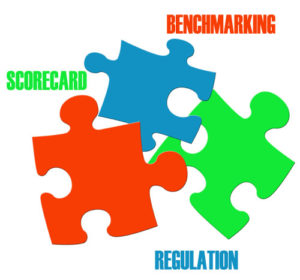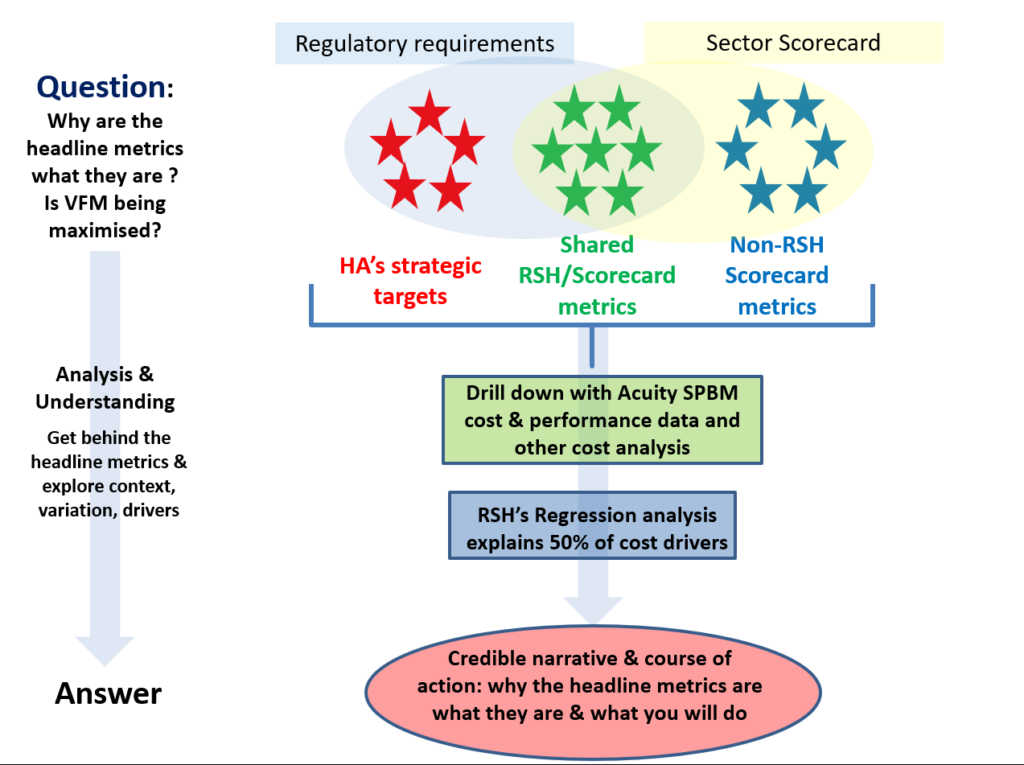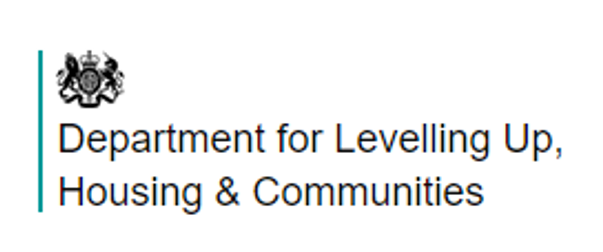
It considers:
- how we got here
- the Regulator of Social Housing’s (RSH) new regulatory metrics
- the Sector Scorecard
- timetable for collecting and reporting the Scorecard data including the RSH sub-set, and
- how it all fits together including Acuity SPBM benchmarking metrics
How did we get here?
Over recent years VFM measurement for housing associations has been in the spotlight. This has resulted in both the regulator and sector concluding that more transparency and consistency in reporting is required – the VFM self-assessment, introduced in 2012, failed to provide a clear picture of sectoral VFM due to the diversity of approaches and therefore undermined comparisons.
As a result the sector came together, under the leadership of Home Group, to develop a Sector Scorecard – a set of high-level metrics that would be relatively easy to collect, enable comparisons and improvement action, and that would tell stakeholders something about organisational VFM (bearing in mind that no single set of metrics can tell us all we need to know given the diversity of the sector).
At the time, this voluntary expression of transparency was seen as being essential to building bridges with a government that was openly hostile toward the sector, particularly about its perceived inefficiency. The Scorecard was piloted in 2017 (2016/17 data) by associations accounting for 84% of the sector’s stock and was relaunched for all associations in March 2018 for 2017/18 data. Details of the relaunch, including registration for 2018 (whether you piloted or not) are here. Findings from the pilot pertaining to smaller associations are covered by this blog.
The regulator was also under political pressure to beef up VFM regulation. In 2016, it introduced a headline social housing cost indicator to nudge (or shove) boards to get a grip on costs. It was accompanied by a sophisticated analysis of justifiable cost drivers to support associations’ cost analysis. It is covered in my blog here. This was the first hint that regulatory metrics might make a comeback. The coalition government had previously torched what they perceived as bureaucracy and heavy-handed regulation, including regulatory bodies and metrics – there was simply no need for them if Localism’s ‘legion of armchair auditors’ were monitoring performance for free.
Going forward, the regulator’s headline social housing cost indicator is joined by a further six metrics that it requires associations to report in the annual accounts along with their own corporate targets.
The consultation period for the regulatory metrics coincided with the Scorecard pilot; there was a risk that the two initiatives would conflict and confuse, eg different metrics measuring similar things or subtly different definitions for essentially the same thing. However, these issues have now been resolved by RSH and the Scorecard working group – the Scorecard has effectively adopted the finalised RSH metrics and deleted others.
Meanwhile, benchmarking services such as Acuity SPBM and HouseMark, continue to provide a:
- business analysis tool for organisational improvement – breadth and depth beyond headline metrics to enable organisations to explore cost and performance variation and take evidence-based action in furtherance of the organisation’s mission
- transparency tool – to communicate both headline and credible supporting data on VFM performance to boards, tenants, regulators, government, etc
Finalised RSH metrics
The RSH’s new approach to VFM is operational from 1 April 2018.
The key things to remember are:
- reporting the regulatory metrics is not optional – it’s a regulatory requirement – you need to include them in your audited accounts this year, ie for 2017/18 financial year
- you also need to report your targets for achieving VFM in delivering your strategic objectives – the regulatory metrics, by themselves, are more to do with business health and capacity and won’t tell the full VFM story
- you’ll need a succinct, focussed narrative to explain why both sets of metrics are what they are. This is likely to draw on a wider set of metrics such as that found in Acuity’s SPBM as well as contextual information, eg the extent of supported or HfOP housing, operating in a high wage area like the south-east, the need to invest in communities to make them work, why new supply might not be an option, etc.
For more on this see my blog on the new approach here and the consultation here.
The finalised RSH metrics, their definitions and a description of key changes from the consultation document are here. Briefly, the metrics and key changes are as follows:
- Reinvestment % – no change
- New supply delivered % (a) Social housing units and b) Non-social housing units – the denominator has changed from units managed to owned. The non-social housing metric denominator now excludes outright sale period end data.
- Gearing – changed to a net debt basis.
- EBITDA MRI – Interest cover (%) – no change to what RSH suggested in its consultation but the RSH’s definition is slightly different to that of the Scorecard pilot in that it removes gain/(loss) on disposal of fixed assets from the operating surplus. This will be the approach going forward.
- Headline social housing cost per unit (including its breakdown into major spend areas eg management, maintenance, etc) – the denominator has changed to units owned and/or managed and excludes leasehold units. The breakdown into major spend areas now allows ‘other’ to be disaggregated so ‘development’ and ‘community/neighbourhood services’ appear as separate items
- Operating Margin % (Overall and Social Housing Lettings) – in line with FRS102, it now includes an adjustment to remove gain/(loss) on disposal of fixed assets from the operating surplus.
- Return on capital employed (ROCE) – no change
The RSH definitions use terminology that will be familiar to finance staff especially (and particularly those who have worked for a larger association and completed an FVA). RSH’s intention is that these metrics should be relatively easy to pull together from existing accounting data. If in doubt about the terminology, it follows that the current accounting direction is a good place to seek clarification as it sets out how providers must prepare their accounts.
Finalised Sector Scorecard metrics
The Sector Scorecard builds on the RSH metrics to provide a broader picture of organisational VFM – effectively a generic high-level VFM dashboard spanning economy, efficiency and effectiveness. Notably, some of the metrics aim to reflect the value or outcomes associations seek to provide as measured by satisfaction and community investment (the shared RSH/Scorecard ‘new supply’ metrics do this too). The efficiency of key business processes are also reflected in occupancy and rent collection measures.
Collecting the Sector Scorecard measures over and above those required by RSH is entirely a voluntary affair but you are encouraged to do it by NHF to enhance sectoral transparency beyond narrow regulatory requirements. This is seen as being an expression of a mature co-regulatory relationship as well as ongoing astute political management. Whilst the regulator does not require you to report the Scorecard’s non-RSH measures in the accounts, it has signalled that it would find the additional data helpful.
The finalised Scorecard metrics and definitions are available here. The guidance incorporates the final RSH metrics discussed above. Briefly, the metrics and key changes are as follows:
- the seven RSH metrics – as in the section above
- customer satisfaction – no change
- £s invested for every £ generated – in new supply – DISCONTINUED – effectively replaced by RSH’s ‘Reinvestment %’ metric
- £s invested for every £ generated – in communities – DISCONTINUED, just the numerator will be collected as a new metric: ‘cash paid for community investment activities’
- occupancy – no change
- ratio of responsive to planned maintenance spend – no change
- rent collected – no change
- overheads as a % of adjusted turnover – minor amendment to better align to HouseMark’s existing indicator
As with the pilot phase, Acuity and HouseMark will collect the data on behalf of the sector going forward.
Timetable for collecting and reporting the Scorecard data including the RSH sub-set
- from April – Acuity SPBM will include the Scorecard metrics and their definitions on your data entry form. They can be easily identified by the prefix ‘SS’ unless they:
- already exist as established SPBM metrics, ie customer satisfaction (STA 001), rent collected (GNPI 28) and overheads (CPP 04)
- feature in the regulatory subset, in which case they are prefixed ‘RSH’
Ensure you are familiar with the definitions. The updated guidance manual is here -it brings all the definitions, including the RSH subset, together in the one place.
- end of June – deadline for initial data submission to be included in HouseMark’s initial aggregated sectoral report
- from late June – run your own Scorecard reports (including RSH metrics) from live data. We’re going to make this as easy as possible by automating it
- end of September – deadline for any amended data to be included in HouseMark’s final sectoral report which will also include the results for all participants in alphabetical order and not a league table!
Remember you need to report the RSH metrics and your targets for achieving VFM in delivering your strategic objectives in your 2017/18 final accounts.
Acuity’s thoughts on how sector metrics fit together
As noted, the Scorecard, including the RSH metrics, effectively amounts to a generic high-level VFM dashboard. The addition of your targets for achieving VFM in delivering your strategic objectives means that the dashboard takes on a more bespoke reflection of your mission. The generic measures allow comparisons with others on general VFM/business health, whilst the strategic targets mean nobody loses sight of why you exist and what you are trying to do!
Depending on what your targets are it’s possible that your performance may be compared too, eg against standard satisfaction measures, end-to-end repairs times, revenue maximisation targets (arrears and void loss reduction, increasing rent collection), etc. Some targets might overlap with Scorecard metrics too eg, increase new supply and reduce headline costs/overhead costs. Clearly, some of these strategic objectives may not relate directly to the value or outcomes you are seeking to deliver – rather they are indirect enablers to maximising that value or even mitigating viability risks in a challenging environment. You can explain this in the narrative that accompanies the reported metrics in your final accounts.
This combination of generic and local metrics is likely to usefully complement your corporate scorecard and serves as the starting point for associations to get to grips with VFM by drilling deeper to understand why the headline metrics are what they are and determine an evidence-based course of action (see diagram).
Examples of where you can drill down from high level to more detailed data to analyse and understand cost and performance drivers include:
| Headline metric | Driver analysis: lifting the lid on the headline metric |
| Headline social housing costs | Acuity CPP series which also includes the Scorecard Overheads measure:
NB the breakdown of the RSH’s Headline social housing metric into its major spend components eg management, maintenance, etc is unreliable for comparison purposes. SPBM’s RC series is useful for breaking down maintenance spend into its component elements. |
| Occupancy | Acuity SPBM’s metrics:
|
| Rent Collected | Acuity SPBM’s metrics:
|
| Customer satisfaction | Acuity SPBM’s range of standard satisfaction metrics. Eg ‘satisfaction with repairs’ is a known key driver for overall customer satisfaction |
How Acuity can help
We hope this briefing has been a useful introduction to making sense of current sectoral VFM measurement. We shall issue further blogs/briefings as the need arises.
You can hear from Rob Dryburgh, the regulator’s lead on VFM, at our upcoming annual conference on 19 April.
We shall also be running our well-received VFM Masterclasses in late May. Details soon.
Need more targeted support? We offer bespoke VFM consultancy, including:
- board/executive briefings on the new VFM requirements, implications and board role
- critical friend support for your approach to reporting VFM in the accounts
- reviewing/improving the way you measure and report VFM from Board to operations
Want to talk about any of this? Contact me at steve.smedley@arap.co.uk







Comments are closed.